|
Report
from
Europe
Slow recovery in EU imports of tropical hardwood logs
During the first half of 2011, the EU imported 198,300
cu.m of hardwood logs from tropical countries, a 5%
increase compared to the same period in 2010.
As natural forest logs can no longer be exported from
Gabon, EU imports from all the other main producing
countries in the Congo region increased dramatically
during the first 6 months of the year.
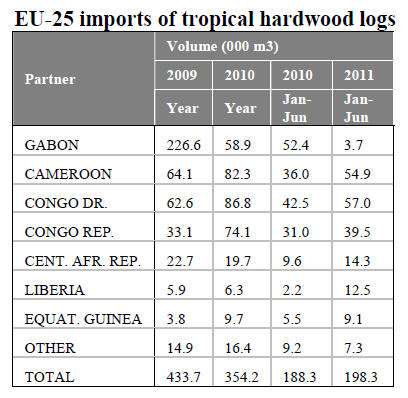
EU imports of tropical hardwood logs in the second
quarter of 2011 reached 105,000 cu.m. Quarterly imports
have risen now for three consecutive quarters, recovering
from a low of only 78,000 cu.m imported in the third
quarter of 2010.
However as shown below EU quarterly imports of tropical
hardwood logs over the last three years that imports of this
commodity are only 50% of levels recorded in early 2008.
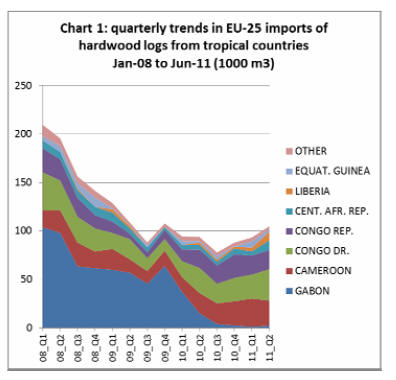
There are various reasons for this including the economic
recession in Europe, Gabon¡¯s log export ban from May
2010 and the significant recent decline in okoume
plywood manufacturing in France.
Shipments of tropical hardwood logs to Europe during the
second half of 2011 are unlikely to show any significant
improvement. Buying was slow to pick up at the end of
the European holiday season in September.
Consumption is so slow that there are few reports of
significant delays in deliver to end-users despite
continuing reports of delayed shipments from African
suppliers.
Decline in log imports not off-set by increased veneer imports
The following table shows recent trends in EU-25 imports
of hardwood veneer and indicates that the decline in EU
imports of tropical hardwood logs has not yet been offset
by an increase in imports of tropical hardwood veneer.
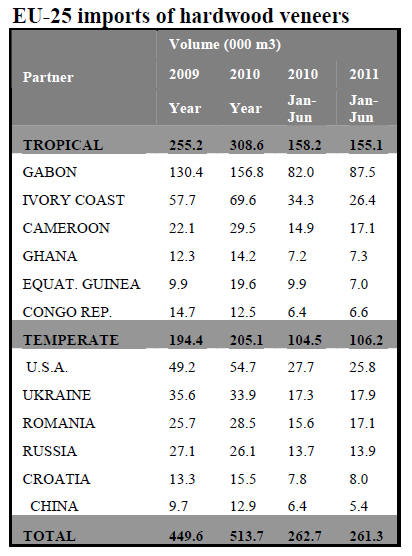
EU imports of this commodity reached 155,100 cu.m in
the first six months of 2011, down 1.9% compared to the
same period in 2010. A slight increase in imports from
Gabon and Cameroon was more than offset by a large
decline in imports from Ivory Coast and Equatorial
Guinea.
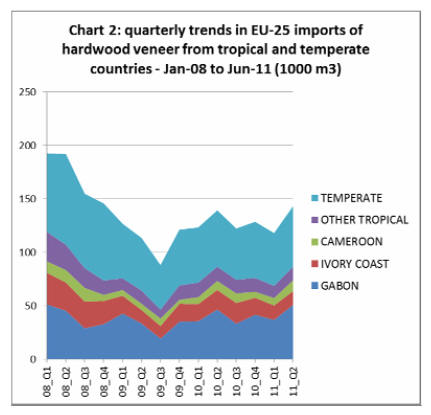
On a more positive note EU imports of tropical hardwood
veneer, particularly from Gabon, rose sharply in the April
to June 2011 period after a very slow start to the year.
It remains to be seen whether recent efforts to increase
investment in Gabon¡¯s wood processing sector will lead to
this becoming a sustained trend.
The relative stability of EU imports of hardwood veneer
during 2011 masks deeper processes of on-going structural
change in the sector. The reality is that there is
considerable uncertainty about longer term market
prospects which is encouraging a conservative approach to
purchasing.
The European market for rotary veneers of tropical
hardwood appears to be in long-term decline as okoume
plywood manufacturing operations in Europe have closed
and okoume plywood has come under intense pressure
from cheaper products (particularly combi-products) from
China comprising a poplar core and decorative hardwood
face veneer.
Meanwhile, demand for high quality tropical hardwood
sliced veneers has been hit by a combination of factors.
European manufacturers are increasingly switching to
domestic hardwoods to reduce costs and supply chain risks
in a market where nobody wants to be caught holding too
much stock.
This trend has gone hand-in-hand with improvements in
treatment technologies allowing even the blandest of
temperate hardwoods to produce a diversity of looks and
finishes.
The most recent data from Germany, traditionally the
centre of the European veneer trade, gives some indication
of how far this trend has progressed. The latest survey of
the German veneer industry by GD-Holz suggests that
European hardwoods now account for 63% of veneer
manufacturing, up from 56% last year.
This year oak (both European and American) makes up
38% of total production, with beech, maple and walnut
contributing a further 23%, 9%, and 8% respectively.
Tropical hardwood currently accounts for around 15% of
German veneer production.
At the same time, all sliced wood veneers continue to
come under pressure from non-wood substitutes and from
weak consumption in major end-using sectors. Despite
concerted marketing efforts by the European veneer
sector, European furniture and door producers are still
shifting to non-wood alternatives.
These losses have only been partly off-set by gains made
in sales to the interior fittings market (floors and
edges/borders) and higher value niche markets such as
yachts, cars, and airplanes.
Hardwood plywood prices weaken as supply pressures ease
Availability of South East Asian plywood for forward
shipment to Europe has improved in recent weeks. The
supply problems that arose for European importers early in
the year following the Japanese Tsunami have now eased.
Although the log supplies to mills in Indonesia and
Malaysia remains at relatively low levels, they are now
reportedly sufficient to meet current subdued levels of
demand. The slight improvement in log supply has
coincided with slower consumption in Japan and
continuing weak demand in Europe and North America.
Some mills in Malaysia are now offering BB/CC grade
plywood to European buyers at lower prices than in
September. However quality is now quite variable
between Malaysian mills.
Prices for Indonesian plywood have remained more stable,
but supply pressures are now less pronounced and lead
times for some Indonesian products for delivery to Europe
have fallen to around 5 weeks.
Demand for Chinese plywood in Europe remains slow.
The UK is quite heavily stocked relative to current levels
of subdued consumption so that forward buying has been
slow in the autumn months.
The German trade journal EUWID reports that
consumption of Chinese hardwood plywood in Germany is
so slow that some merchants have introduced promotional
offers on their existing stocks.
EUWID reports that Chinese exporters have pushed up
FOB prices for hardwood plywood in response to rising
labour and raw material costs. However, this has been
offset for European buyers by falling freight rates.
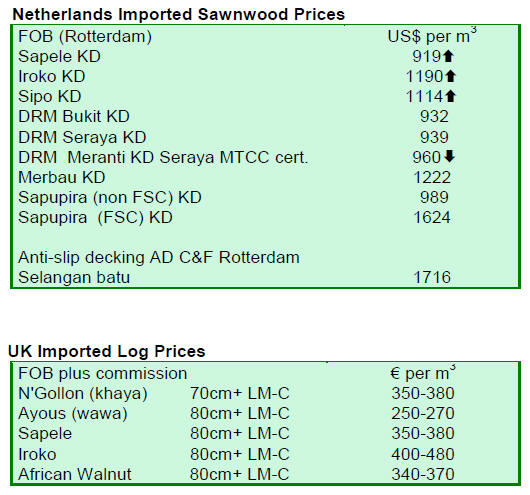
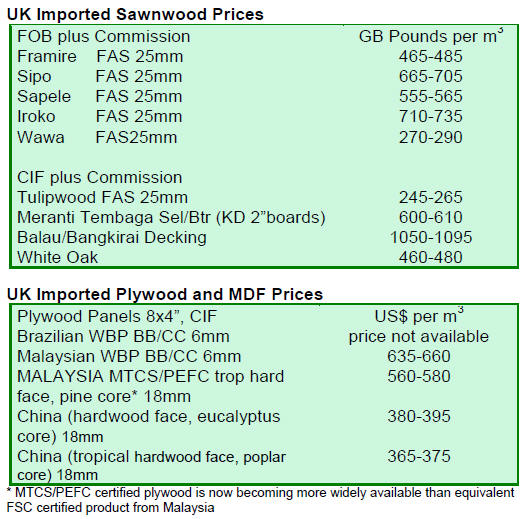
¡¡ Related News:
|